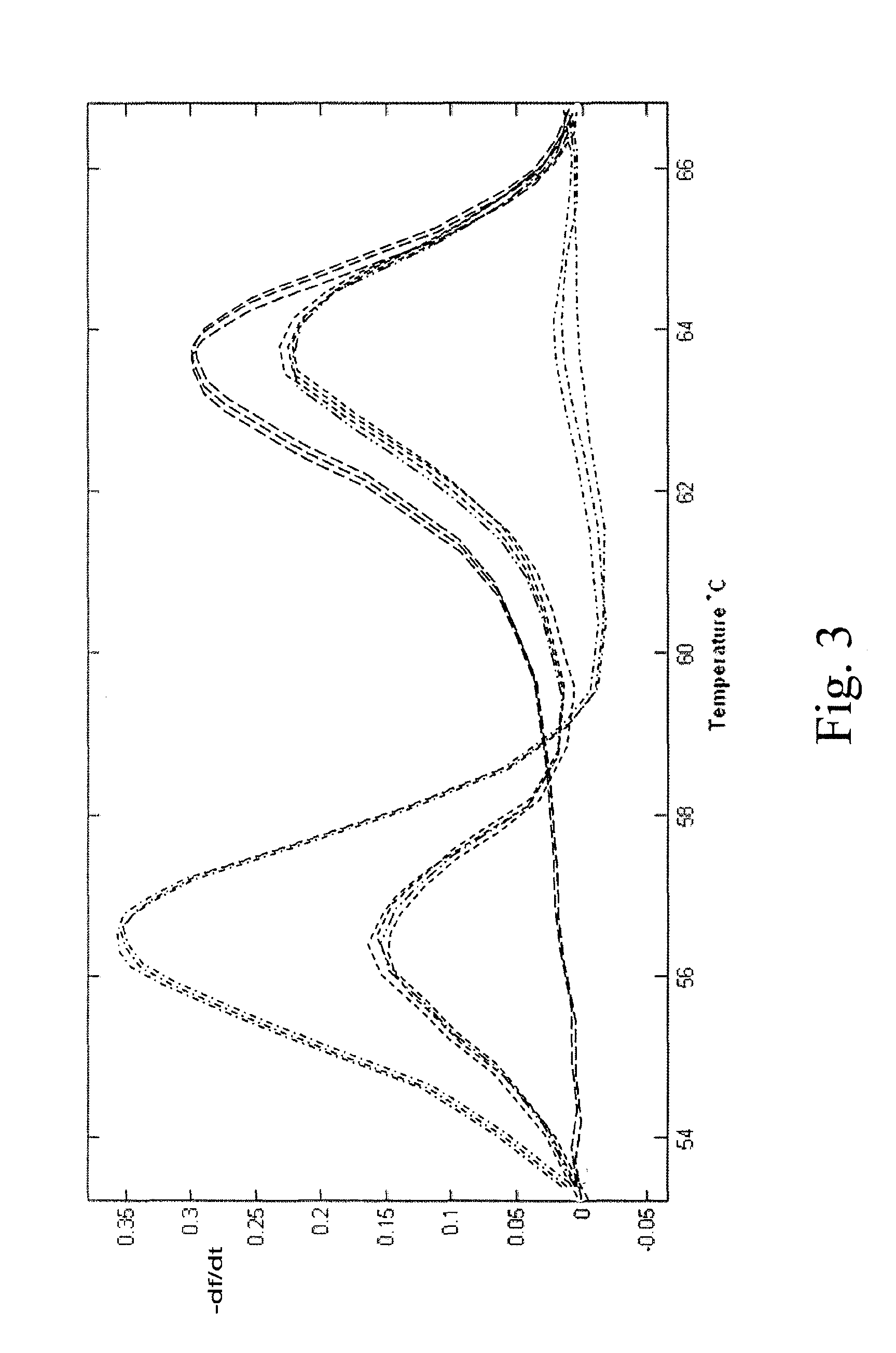Allele amplification bias
a technology of alleles and biases, applied in the field of allele amplification bias, can solve the problems of difficult detection of alleles, inability to apply alleles in routine medical practice, and inability to quickly and easily detect alleles, and achieve the effect of greater resolution of mutant alleles
- Summary
- Abstract
- Description
- Claims
- Application Information
AI Technical Summary
Benefits of technology
Problems solved by technology
Method used
Image
Examples
example 1
Genotyping Using High Resolution Melting
[0052]The malaria P. falciparum CRT gene was amplified using the following primers and probe:
[0053]
(SEQ ID NO. 1)pfCRT Fwd-5′ TTCTTGTCTTGGTAAATGTGCTCA(SEQ ID NO. 2)pfCRT Rev-5′ CGGATGTTACAAAACTATAGTTACCAAT(SEQ ID NO. 3)pfCRT Probe-5′ GTGTATGTGTAATGAATAAAATTTTTG-C3blocker
For the probe, the underlined bases are the SNP sites, with the bases shown matched to the wild type. While five SNP sites are shown, only four were used in this study.
[0054]Amplification was performed with an initial hold of 30 sec. at 95° C., followed by 55 cycles of 95° C. for 2 sec., 58° C. for 15 sec., with a ramp rate measured at approximately 4 to 6° C. / s., on 3D7 (wild type) two mutant strains (7G8 and Dd2) of the malaria P. falciparum CRT gene. Subsequent to thermal cycling, the samples were held at 95° C. for 2 sec. and then cooled to 40° C. for 30 sec., with a cooling ramp rate of 10° C. / s. Melting was from 45° C. to 88° C., with a 0.3° C. / s ramp rate and continuous ...
example 2
Low Allele Fraction Detection
[0055]The malaria P. falciparum CRT gene was amplified using the primers and probe described above. Mixtures containing various ratios of the wild type and the 7G8 mutant from above were prepared.
[0056]Based on observed Tms of the unlabeled probe (62° C. and 54° C. for the wild type and mutant alleles, respectively), an annealing temperature of 58° C. was used (low Tm+½ΔTm) to induce allele amplification bias of the mutant allele in a dilution series of mixed samples. Rapid cycling (ramp rate 6-10° C.) was performed on an LS32, and the results are shown in FIG. 2. This protocol resulted in an allele amplification bias factor of approximately 10×, which permitted discrimination of the mutant allele down to 0.75-1.5%. Further experiments have confirmed this finding, allowing for discrimination down to approximately 0.1%. While an annealing temperature about half way between the two Tms was used, it is understood that any Tm may be used that destabilizes di...
example 3
Effects of Thermal Cycling Ramp Rate
[0058]A traditional block thermal cycler was used for this example, having a ramp rate of 1.5 to 2.0° C. FIG. 3 shows amplification of malaria CRT gene: wild type 3D7 strain (————), mutant 7G8 strain (- • - • - • -), and a heterozygote with an equal allele ratio), (- - - - - -), in the presence of an exo− polymerase, with an initial denaturation of a 2 min hold at 95° C., followed by 55 cycles of 94° C. for 30 sec, 30 sec of a programmed gradient annealing step between 50 and 68° C. (50° C., 51.4° C., 53.6° C., 56.8° C., 61.4° C., 64.6° C., 66.8° C., and 68° C.), that is, each sample was cycled using a 94° C. denaturation temperature and one of the various annealing temperatures. FIG. 3 shows no evidence in the heterozygotes of preferential amplification of the lower Tm allele despite eight different annealing temperatures used. Four samples amplified using the 56.8° C. and 61.4° C. (maximal allele amplification bias is predicted to be in this ran...
PUM
| Property | Measurement | Unit |
|---|---|---|
| temperature | aaaaa | aaaaa |
| temperature | aaaaa | aaaaa |
| Tm | aaaaa | aaaaa |
Abstract
Description
Claims
Application Information
 Login to View More
Login to View More - R&D
- Intellectual Property
- Life Sciences
- Materials
- Tech Scout
- Unparalleled Data Quality
- Higher Quality Content
- 60% Fewer Hallucinations
Browse by: Latest US Patents, China's latest patents, Technical Efficacy Thesaurus, Application Domain, Technology Topic, Popular Technical Reports.
© 2025 PatSnap. All rights reserved.Legal|Privacy policy|Modern Slavery Act Transparency Statement|Sitemap|About US| Contact US: help@patsnap.com



